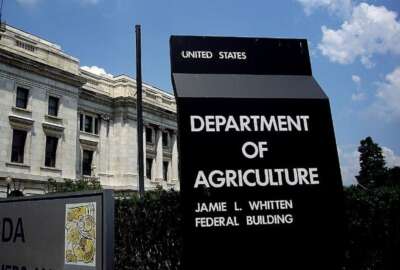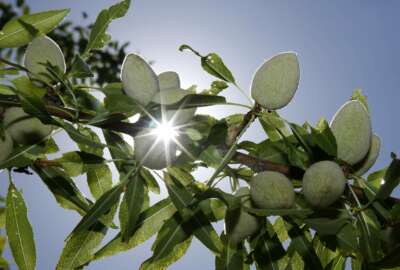What new USDA farms census tells America
The Agriculture Department's (USDA) National Agricultural Statistics Service recently issued its latest count of farms and ranches in the United States.
The Census Bureau counts people in the United States. The Agriculture Department counts farms. In fact, the National Agricultural Statistics Service recently issued its latest count of farms and ranches in the United States. For the details, the Federal Drive with Tom Temin spoke Bryan Combs, the USDA Chief of the Environmental, Economics and Demographics Branch.
Interview Transcript:
Tom Temin You know, tell us your methodology for gathering this information, because it’s a constantly changing landscape with mergers and acquisitions. And how do you count farms and ranches?
Bryan Combs So once every five years, National Agricultural Statistics Service goes out to approximately 3 million farms. And we do that by sending out Census of Agriculture forms to those producers. And ask them to return that. We start that data collection process in November of the census year. And we collect data through the first part of the next year before we start summarizing and putting out all the details.
Tom Temin So it’s a paper type of mail process.
Bryan Combs That is correct. We typically will send out survey forms. We do have online reporting that is available to producers. The large majority of forms are returned via mail. However, we have been seeing an increase in those online responses.
Tom Temin And how do you count multi-location conglomerates? Because most farms nowadays are corporate. And so, you have a Tysons or this company or that company that might have, I don’t know, 25 chicken farming locations or whatever. Is that one farm, is it 25 farms? How does that work?
Bryan Combs So we actually count based on the producer that’s operating that. So, if they have multiple locations, we do consider that as one farm. And then we try to break that production out based on the state county that those multiple operations are in. One thing I would note is that the large majority of farms are actually family farms, and not actually corporate farms.
Tom Temin I guess maybe economically it’s mostly corporate or not that case either.
Bryan Combs It’s really not that case at all. Approximately 95% of farms are family farms. Now, some of those farms could still be very large. However, they’re not really owned by corporations. They’re more family-oriented farms.
Tom Temin Right. And what counts as a farm, I mean, like the ranch, you can tell, you know, they grow livestock, or they grow crops. What about beekeepers and that kind of thing?
Bryan Combs Yes. So, we define a farm as any place which produced or would have produced $1,000 worth of agricultural products on that operation.
Tom Temin So that could be even an urban farm could produce that much.
Bryan Combs Yes. The definition to qualify is not a very high threshold. So that could be many different makeups of, of agricultural production that could qualify to use the farm.
Tom Temin I guess you could sell five orchids for 200 bucks each and you would get into the census.
Bryan Combs Yes, that is correct. So, we typically tell producers when you get that form to complete it and let us evaluate it and determine if you are a farm, because we do want to make sure we count all activity that’s going on across the US.
Tom Temin All right. So, between the 18 count and the 2022 count or 17 and 22, what emerged? What are the big trends people should understand about agriculture in the United States?
Bryan Combs One of the things we did see is we did see a decline in the number of farms in the land and farms. So, the number of farms were 1.9 million, and that covered about 880.1 million acres. There were 3.4 million producers that were counted in the 2022 Census of agriculture. Some of the other major changes there. They produced $543.1 billion in agricultural products, and that was up from 388.5 billion in 2017.
Tom Temin All right. So, there’s fewer farms but greater value that they’re producing. Of course, that depends on commodity prices at a given moment.
Bryan Combs That is correct. So, there were fewer farms, but there was a pretty substantial difference in the value of commodities from 2017 to 2022. As you mentioned, that was largely driven by some pretty high commodity prices for both crops and livestock over that period.
Tom Temin And do you also get at productivity of farms? Because the thing that’s enabled the United States to be such a giant food producer relative to the 1800s, when there was ten times as much farmland. It’s all about productivity and scientific innovation.
Bryan Combs Yes. And that’s one of the very interesting things in the, the census data series, you can actually see that change in productivity over time. So, dating back to the, you know, the 1800s when the first censuses were conducted, you can track that, largely speaking, every five years. There were some gaps in the census data series, but you can track and see how that productivity has changed and structurally, how agriculture has changed over those various census cycles.
Tom Temin We’re speaking with Brian Combs. He’s chief of the Environmental Economics and Demographics branch of the National Agricultural Statistics Service. And how does the USDA use this information? I mean, it’s a nice picture, and we know how many farms they are and where they are. What do you do with that information?
Bryan Combs Yeah. So. That’s another great thing about census is it collects data down to the county level for all counties and parishes boroughs across the U.S.. That data is used in many ways. We look at right now, Congress is looking at, you know, farm bill legislation. They’ll be going to be looking closely at this as a resource to help make decision making on how the new policies for USDA, for the farm bill are going to shape up. State and county governments can use this to do the same thing, to look at programs to help support the agricultural activity, or possibly even industries that are in their area.
Tom Temin And given that level that you mentioned $1,000 of production worth in a given year, that means that you tell me there are actual farms still in New York City. There’s probably a farm in Manhattan at $1,000.
Bryan Combs Yes. And that’s, you know, one of the trends we’re starting to see is with some of you mentioned urban agriculture, that those are a growing population, that if they do meet that definition, we do qualify them as a farm and would report on them, as you mentioned. So, we get into those more urban areas. The farms are pretty sparse for the most part, so may not always have data publishable on those, but we do make all efforts to collect that if it’s there.
Tom Temin You know, a tree grows in Brooklyn, but maybe not so much corn. But a moment ago I mentioned orchids, but that really wouldn’t count. It has to be food, right? To be a farm. Otherwise, it’s horticulture.
Bryan Combs No, we collect horticulture if those are agricultural products that are being produced. So, fruits, vegetables, horticulture saw there’s a, there’s a ton of different potential and other needs that could qualify use a farm. So yeah it doesn’t have to be just that traditional, you know corn and cattle type things that that others may think.
Tom Temin So that would include also like wood products like lumber and hardwoods and so on.
Bryan Combs That doesn’t qualify you as a farm if you have farm production, which would be one of the agricultural related commodities, but also have some timber production in the world, or something of that nature that’s considered as farm related income. But you must first qualify as a farm before we would actually pick up and report on that value.
Tom Temin So timber then generally not part of it.
Bryan Combs Correct. Is not the not part of the agricultural census.
Tom Temin But it could be floral and so on.
Bryan Combs Yes, that is correct.
Tom Temin And the department itself must use this to allocate resources for the there’s a myriad of farm support programs and so on loan programs to plan where all of that should be going. Fair to say.
Bryan Combs Yes, that is true, that the department is a big user of the sensitive agricultural data. It allows them the ability to look at their programs and what impact they potentially had over a period of time, and then to plan for new programs as they’re looking at how they can best support, you know, the farmers and ranchers across the country through the department’s programs.
Tom Temin And I imagine the report is pretty highly read in the relevant precincts of Congress, committees and so forth that have to do with agriculture and the Agriculture Department.
Bryan Combs Yes, it is. They are they are big users. We actually have a congressional district summarization that we actually provide to the Congress, so they can see what agricultural activity is within their specific congressional district.
Tom Temin All right. And tell us about yourself a little bit. Do you come at this from a farming type of background in the family, or are you strictly an academic here that counts things?
Bryan Combs Yes. So, both of my parents grew up on working farms. They were some of those farms that were lost back in the late 70s, early 80s, and I’ve always just had a passion for it. I grew up in a rural, rural area of southwestern Virginia, studied agricultural economics, and then became a statistician. So, I’ve worked for the agency for approximately about 17 years, spent a lot of time in upstate New York working on livestock and dairy estimates, and then, came into DC to work here NASS for, for several years. And my more recent to this current position, I was chief of staff for about seven years for the agency and, you know, really enjoyed getting back into, to the actual work that we do in publishing the census of agriculture and many of the other environmental and economic reports that we put out.
Tom Temin And do you ever get out to a farm or two throughout the year just to kind of smell it and taste it and see what it’s like in reality?
Bryan Combs Yeah. So actually, when I, when I get back home to visit my folks, I often get to go to visit friends and family that are still, still farming in the area and kind of stay connected to those, those agricultural producers.
Copyright © 2024 Federal News Network. All rights reserved. This website is not intended for users located within the European Economic Area.
Tom Temin is host of the Federal Drive and has been providing insight on federal technology and management issues for more than 30 years.
Follow @tteminWFED






